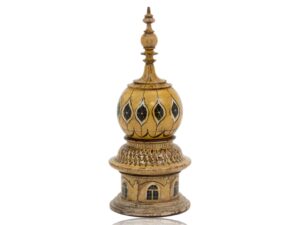Tunbridge Ware Musical Jewellery Box Barton
SOLD
Fitted with an internal Music Box From our Tunbridge Ware collection, we are delighted to offer this Tunbridge Ware Musical Jewellery Box by Thomas Barton. The Tunbridge Ware Box of slim rectangular shape is veneered with a strip of exotic... Read More
T. Barton, Mount Ephraim
| Dimensions | 28 × 12 × 9 cm |
|---|---|
| Country | |
| Period | |
| Year | |
| Medium | |
| SKU | 501423 |
Description
Description
Fitted with an internal Music Box
From our Tunbridge Ware collection, we are delighted to offer this Tunbridge Ware Musical Jewellery Box by Thomas Barton. The Tunbridge Ware Box of slim rectangular shape is veneered with a strip of exotic Coromandel wood above a band of classic Tunbridge Ware inlaid blossoming flowers. The lid of the box has a chamfered edge with a flowing geometric pattern and is finished to the lid with a framed floral scene matching the exterior and raised upon four ball and claw feet. The base of the Jewellery Box is labelled T. Barton, manufacturer, Mount Ephraim, Tunbridge Wells and has the music box winder to the right hand side. When opened the Jewellery Box has a small pin which activates the music box to play when the lid is raised. The interior of the Jewellery Box is lined in purple velvet and contains a stepped compartment to the left and a larger storage compartment to the right. The Tunbridge Ware Jewellery Box dates to the second half of the 19th century during the Victorian period Circa 1875.
Measurements (inches) 3.5 High x 11cm Wide x 4.7 Deep
Thomas Barton was a Tunbridge Ware manufacture from circa 1862-1911. Born in Clerkenwell London in 1820 Barton began working for famous Tunbridge Ware manufacture Edmund Nye circa 1836. Bartons ability was shown at the 1851 Great Exhibition when Nye exhibited two tables which were believed to be designed by Barton. By the 1850s Barton was described as the Foreman of the company and as Nye passed he gave Barton the option of inheriting his business, Barton took over in 1862 and maintained the business from Mount Ephraim working under his own title. He won first prize at an Industrial Exhibition in the town for an image of Battle Abbey Gatehouse in September 1864 and his business prospered over the next 10 years having 14 employees by 1871. His production included a large range of boxes for various uses and accessories and occasionally smaller pieces of furniture such as occasional tables. Barton favoured working with dark wood veneers such as Coromandel and Ebony. In 1901 he suffered from a paralytic seizure and died two years later. The business was continued by his two nieces but on a reduced scale after loosing its figurehead finally closing around 1911.
Tunbridge Ware Tunbridge Wells and Tunbridge in Kent, England became popular in the 17th Century for their therapeutic waters. By the 18th century, Tunbridge Wells was a hugely popular Spa resort. Shops and stalls were set up to sell local work of distinction to visitors as souvenirs. Many of the original boxes were decorated with all sorts of different kinds of designs. Many of the Tunbridge boxes had a central image with views of castles, churches, pavilions, animals, country scenes and sometimes people, such as the Young Prince of Wales. These were surrounded by a variety of bandings and panels of floral and geometric designs. Tunbridge Ware items originate from the beautiful spa town of Royal Tunbridge Wells in Kent. We always have a very good selection which showcases the techniques of tessellated mosaic, stick ware, perspective cube mosaic, vandyke and painted pen work. We always have a selection of artworks and pieces which showcase the techniques of tessellated mosaics, stick ware, perspective cube mosaics, vandykes and painted pens.
Coromandel is a valuable wood found in India, Sri Lanka and South East Asia. It has a contrasting hazel-brown colour with black grain. It is a dense, heavy wood that is so popular it has been logged to extinction over the last few hundred years. This makes Calamander pieces even more special.
Victorian, an era of British History corresponding approximately with the reign of Queen Victoria from the 20th of June 1837 until her death on 22 January 1901 however, there are arguments stating that the Victorian era is actually from 1820 until 1914 proceeded by Georgian era and followed by the Edwardian era.
Every purchase made from Mark Goodger Antiques is accompanied by a comprehensive suite of documents to ensure your satisfaction and peace of mind. This includes our latest catalogue, a Certificate of Authenticity, detailed care instructions for your chosen item, and an independent invoice for insurance purposes. Additionally, your purchase is protected by our no-hassle, money-back policy, and your item will be fully insured during the shipping process to safeguard against damage or loss.
Additional information
Additional information
| Dimensions | 28 × 12 × 9 cm |
|---|---|
| Country | |
| Period | |
| Year | |
| Medium | |
| SKU | 501423 |

















